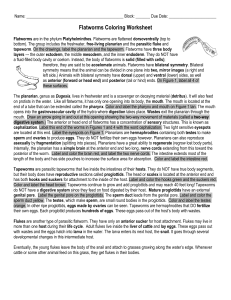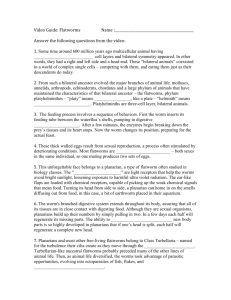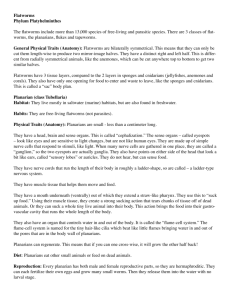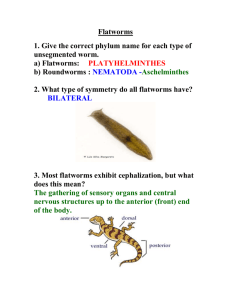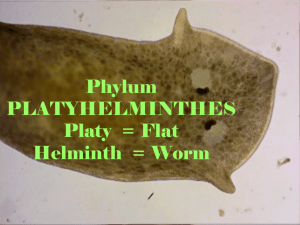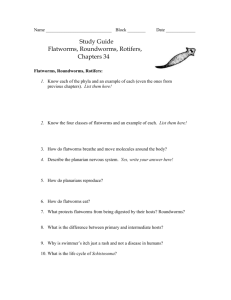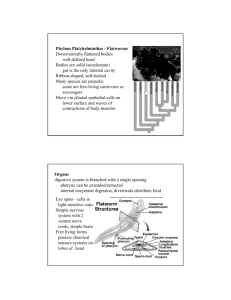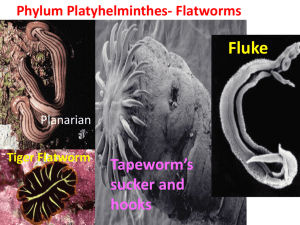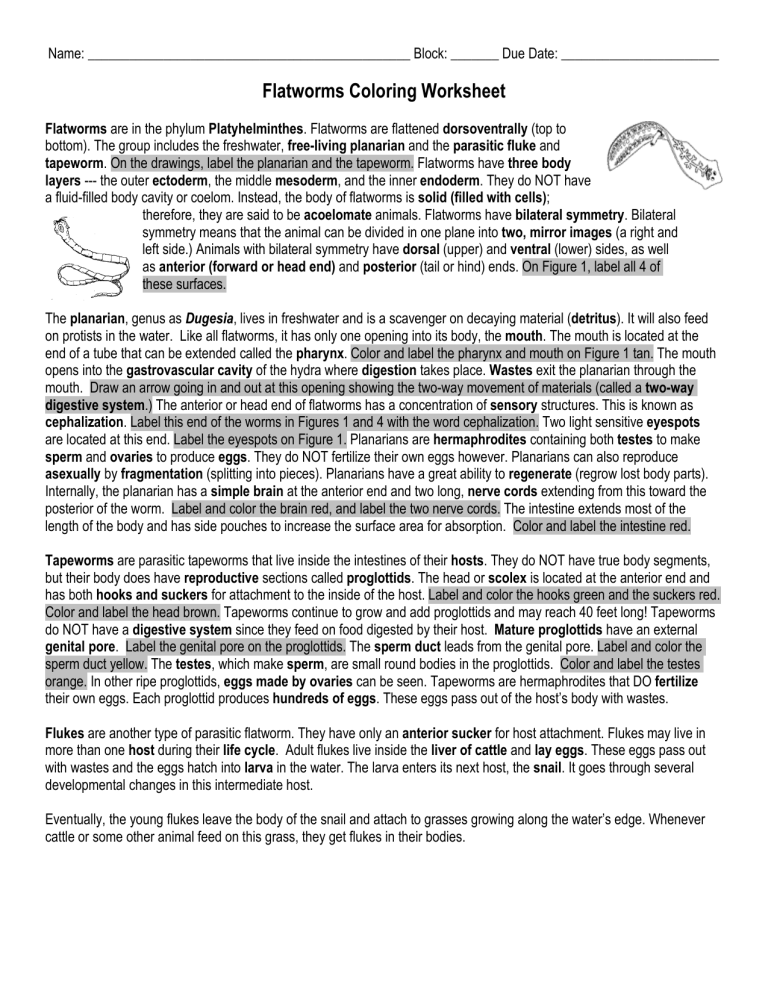
Name: _______________________________________________ Block: _______ Due Date: _______________________ Flatworms Coloring Worksheet Flatworms are in the phylum Platyhelminthes. Flatworms are flattened dorsoventrally (top to bottom). The group includes the freshwater, free-living planarian and the parasitic fluke and tapeworm. On the drawings, label the planarian and the tapeworm. Flatworms have three body layers --- the outer ectoderm, the middle mesoderm, and the inner endoderm. They do NOT have a fluid-filled body cavity or coelom. Instead, the body of flatworms is solid (filled with cells); therefore, they are said to be acoelomate animals. Flatworms have bilateral symmetry. Bilateral symmetry means that the animal can be divided in one plane into two, mirror images (a right and left side.) Animals with bilateral symmetry have dorsal (upper) and ventral (lower) sides, as well as anterior (forward or head end) and posterior (tail or hind) ends. On Figure 1, label all 4 of these surfaces. The planarian, genus as Dugesia, lives in freshwater and is a scavenger on decaying material (detritus). It will also feed on protists in the water. Like all flatworms, it has only one opening into its body, the mouth. The mouth is located at the end of a tube that can be extended called the pharynx. Color and label the pharynx and mouth on Figure 1 tan. The mouth opens into the gastrovascular cavity of the hydra where digestion takes place. Wastes exit the planarian through the mouth. Draw an arrow going in and out at this opening showing the two-way movement of materials (called a two-way digestive system.) The anterior or head end of flatworms has a concentration of sensory structures. This is known as cephalization. Label this end of the worms in Figures 1 and 4 with the word cephalization. Two light sensitive eyespots are located at this end. Label the eyespots on Figure 1. Planarians are hermaphrodites containing both testes to make sperm and ovaries to produce eggs. They do NOT fertilize their own eggs however. Planarians can also reproduce asexually by fragmentation (splitting into pieces). Planarians have a great ability to regenerate (regrow lost body parts). Internally, the planarian has a simple brain at the anterior end and two long, nerve cords extending from this toward the posterior of the worm. Label and color the brain red, and label the two nerve cords. The intestine extends most of the length of the body and has side pouches to increase the surface area for absorption. Color and label the intestine red. Tapeworms are parasitic tapeworms that live inside the intestines of their hosts. They do NOT have true body segments, but their body does have reproductive sections called proglottids. The head or scolex is located at the anterior end and has both hooks and suckers for attachment to the inside of the host. Label and color the hooks green and the suckers red. Color and label the head brown. Tapeworms continue to grow and add proglottids and may reach 40 feet long! Tapeworms do NOT have a digestive system since they feed on food digested by their host. Mature proglottids have an external genital pore. Label the genital pore on the proglottids. The sperm duct leads from the genital pore. Label and color the sperm duct yellow. The testes, which make sperm, are small round bodies in the proglottids. Color and label the testes orange. In other ripe proglottids, eggs made by ovaries can be seen. Tapeworms are hermaphrodites that DO fertilize their own eggs. Each proglottid produces hundreds of eggs. These eggs pass out of the host’s body with wastes. Flukes are another type of parasitic flatworm. They have only an anterior sucker for host attachment. Flukes may live in more than one host during their life cycle. Adult flukes live inside the liver of cattle and lay eggs. These eggs pass out with wastes and the eggs hatch into larva in the water. The larva enters its next host, the snail. It goes through several developmental changes in this intermediate host. Eventually, the young flukes leave the body of the snail and attach to grasses growing along the water’s edge. Whenever cattle or some other animal feed on this grass, they get flukes in their bodies. Questions 1. Explain why planarians and flukes are called flatworms. 2. Name 2 parasitic flatworms. 3. What type of digestive system do flatworms have? How many body openings do they have? 4. Describe the nervous system and sensory structures of the planarian. 5. Why do tapeworms not have a digested system? 6. What are proglottids? What is the scolex? 7. How do tapeworms attach to a host? 8. Describe fragmentation in the planarian. 9. What is meant by cephalization? Do flatworms show this? 10. Name the hosts for a fluke. 11. How many cell layers do flatworms have? Name them. 12. Planarians are hermaphrodites. What does this mean? 13. Do planarians fertilize their own eggs? 14. Do tapeworms fertilize their own eggs? Labeling & Coloring Figure 1 – External Anatomy Figure 2 – Internal Anatomy Figure 3 – Fluke Life Cycle Figure 4 – Tapeworm
